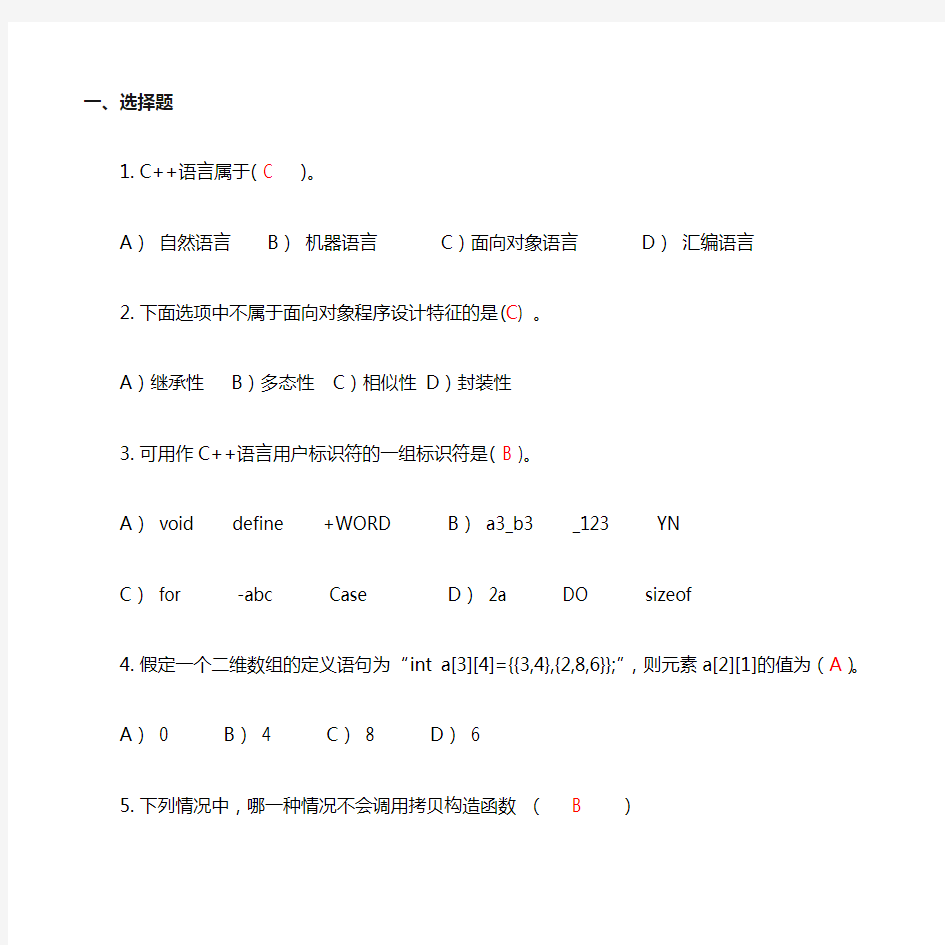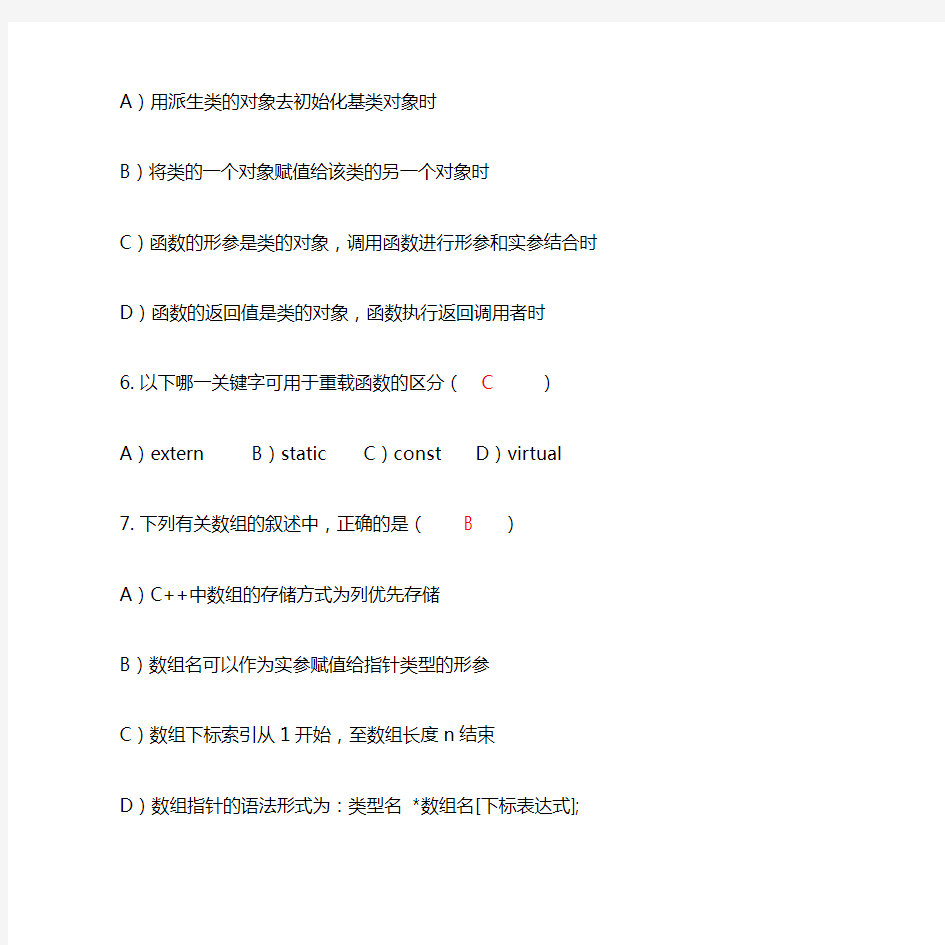c练习题(带答案)56648


一、选择题
1.C++语言属于( C )。
A)自然语言 B)机器语言 C)面向对象语言 D)汇编语言2.下面选项中不属于面向对象程序设计特征的是(C) 。
A)继承性 B)多态性 C)相似性 D)封装性
3.可用作C++语言用户标识符的一组标识符是( B )。
A) void define +WORD B) a3_b3 _123 YN
C) for -abc Case D) 2a DO sizeof
4.假定一个二维数组的定义语句为“int a[3][4]={{3,4},{2,8,6}};”,则元素
a[2][1]的值为(A)。
A) 0 B) 4 C) 8 D) 6
5.下列情况中,哪一种情况不会调用拷贝构造函数( B )
A)用派生类的对象去初始化基类对象时
B)将类的一个对象赋值给该类的另一个对象时
C)函数的形参是类的对象,调用函数进行形参和实参结合时
D)函数的返回值是类的对象,函数执行返回调用者时
6.以下哪一关键字可用于重载函数的区分(C)
A)extern B)static C)const D)virtual
7.下列有关数组的叙述中,正确的是( B )
A)C++中数组的存储方式为列优先存储
B)数组名可以作为实参赋值给指针类型的形参
C)数组下标索引从1开始,至数组长度n结束
D)数组指针的语法形式为:类型名 *数组名[下标表达式];
8.下列有关继承和派生的叙述中,正确的是( C )
A)派生类不能访问通过私有继承的基类的保护成员
B)多继承的虚基类不能够实例化
C)如果基类没有默认构造函数,派生类就应当声明带形参的构造函数
D)基类的析构函数和虚函数都不能够被继承,需要在派生类中重新实现
9.实现运行时多态的机制是( A )
A)虚函数B)重载函数C)静态函数D)模版函数
10.若有下面的函数调用:
fun(a+b, 3, max(n-1, b));
其中实参的个数是( A)
A)3 B)4 C)5 D)6
11.下列关于this指针的说法正确的是( B)
A)this指针存在于每个函数之中
B)在类的非静态函数中this指针指向调用该函数的对象
C)this指针是指向虚函数表的指针
D)this指针是指向类的函数成员的指针
12.在下列关于C++函数的叙述中,正确的是(C)
A)每个函数至少要有一个参数B)每个函数都必须返回一个值
C)函数在被调用之前必须先声明D)函数不能自己调用自己
13.下列运算符中,不能重载的是(C)
A)&& B)!= C). D)->
14.下面程序的输出结果是(B)
#include
using namespace std;
int i = 0;
int fun(int n)
{
static int a = 2;
a++;
return a+n;
}
void main()
{
int k = 5;
{
int i = 2;
k += fun(i);
}
k += fun(i);
cout << k;
}
A)13 B)14 C)15 D)16
15.下面的程序段的运行结果为(D)
char str[] = "job", *p = str;
cout << *(p+2) << endl;
A)98 B)无输出结果 C)字符’b’的地址 D)字符’b’
16.下面程序的输出结果是( C )
#include
using namespace std;
class A
{
public:
A (int i) { x = i; }
void dispa () { cout << x << “,”; }
private :
int x ;
};
class B : public A
{
public:
B(int i) : A(i+10) { x = i; }
void dispb() { dispa(); cout << x << endl; } private :
int x ;
};
void main()
{
B b(2);
();
}
A)10,2 B)12,10 C)12,2 D)2,2
17.下面程序的输出结果是( C)
#include
using namespace std;
class Base
{
public:
Base(int i) { cout << i; }
~Base () { }
};
class Base1: virtual public Base
{
public:
Base1(int i, int j=0) : Base(j) { cout << i; }
~Base1() {}
};
class Base2: virtual public Base
{
public:
Base2(int i, int j=0) : Base(j) { cout << i; }
~Base2() {}
};
class Derived : public Base2, public Base1
{
public:
Derived(int a, int b, int c, int d) : mem1(a), mem2(b), Base1(c), Base2(d), Base(a)
{ cout << b; }
private:
Base2 mem2;
Base1 mem1;
};
void main() { Derived objD (1, 2, 3, 4); }
A)134122 B)123412 C)D)143212
18.下面程序的输出结果是(C)
#include
using namespace std;
class Base
{
public:
virtual void f() { cout << “f0+”; }
void g() { cout << “g0+”; }
};
class Derived : public Base
{
public:
void f() { cout << “f+”; }
void g() { cout << “g+”; }
};
void main() { Derived d; Base *p = &d; p->f(); p->g(); }
A)f+g+ B)f0+g+ C)f+g0+ D)f0+g0+
19.下面程序的输出结果是( C )
#include
using namespace std;
class Sample
{
friend long fun (Sample s)
{
if < 2) return 1;
return * fun(Sample);
}
public:
Sample (long a) { x = a; }
private:
long x;
};
void main()
{
int sum = 0;
for (int i=0; i<4; i++)
{
sum += fun(Sample(i));
}
cout << sum;
}A)12 B)16 C)10 D)34 20.以下程序的输出结果是:(D)
#include
using namespace std;
int fun(char *s)
{ char *p=s;
while (*p!='\0') p++;
return (p-s);
}
void main(){
cout< } A.0 B. 1 C. 2 D. 3 21.有如下程序段: int i=1; while(1) { i++; if (i==10) break; if(i%2==0) cout<<’*’; } 执行这个程序段输出字符*的个数是(C) A. 10 B. 3 C. 4 22.下列关于虚基类的描述中,错误的是(C) A. 使用虚基类可以消除由多继承产生的二义性 B. 构造派生类对象时,虚基类的构造函数只被调用一次 C. 声明 class B:virtual public A 说明类B为虚基类 D. 建立派生类对象时,首先调用虚基类的构造函数 23.有下类定义 Class A { Char *a; Public: A():a(0){} A(char *aa) {new char[strlen(aa)+1] B. char[strlen(aa)+1] C. char[strlen(aa)] D. new char[sizeof(aa)-1] 24.假定AA为一个类,a为该类私有的数据成员,GetValue( )为该类公有函数成员, 它返回a的值,x为该类的一个对象,则访问x对象中数据成员a的格式为(X)。 A) B) () C) x->GetValue() D) ( ) 25.假定AA为一个类,int a()为该类的一个成员函数,若该成员函数在类定义体外 定义,则函数头为(A)。 A) int AA::a( ) B) int AA:a() C) AA::a() D) AA::int a() 26.有如下程序: #include using namespace std; class Test{ public: Test(){} ~Test(){cout<<'#';} }; int main(){ Test temp[2], *pTemp[2]; return 0; } 执行这个程序输出星号(#)的个数为(B)。 A)1 B)2 C)3 D)4 27.有如下程序: #include using namespace std; class MyClass{ public: MyClass(int i=0){cout<<1;} MyClass(const MyClass&x){cout<<2;} MyClass& operator=(const MyClass&x){cout<<3; return *this;} ~MyClass(){cout<<4;} }; int main(){ MyClass obj1(1),obj2(2),obj3(obj1); obj1=obj2; return 0; }运行时的输出结果是(A)。 A)1123444 B)11114444 C)121444 D) 28.有如下程序: #include using namespace std; class point { public: static int number; public: point() { number++;} ~point() {number--;} }; int point::number=0; void main() { point *ptr; point A,B; { point *ptr_point=new point[3]; ptr=ptr_point; } point C; delete[] ptr; cout< } 程序结果为(A) A)3 B)4 C)6 D)7 29.友元运算符obj++被C++编译器解释为(D)。 A. operator++(obj) B. operator++(obj,0) B. ++( ) D. ++(0) 二、程序填空 1.用递归法求从1到n的立方和: f(1)=1 (n=1) f(n)=f(n-1)+n3(n>1) #include using namespace std; int f(int); int main(){ int n,s; cout<<"input the number n:"; cin>>n; s= f(n); cout<<"The result is "< return 0; } int f(int n){ 请将下列程序补充完整,使得输出结果为“Destructor Derived Destructor Base”。 #include using namespace std; class Base { public: virtual ~Base () { cout << “Destructor Base”<< endl; } }; class Derived : public Base { public: ~Derived(){ cout << “Destructor Derived” << endl; } }; void main () { Base *pBase = new Derived; delete pBase ; } 三、阅读程序,写出运行结果 1. #include #include using namespace std; class CD { char name[20]; int number; public: void Init(char* aa, int bb) { strcpy(name,aa); number=bb; } char* Getname () {return name;} int Getnumber () {return number;} void Output() {cout<< name <<' '<< number < CD dx; void main() { CD dy; ("歌唱祖国",30); ("义勇军进行曲",3* ()+5); (); (); } 歌唱祖国30 义勇军进行曲95 2.#include using namespace std; int f(int a){ return ++a; } int g(int& a){ return ++a; } void main(){ int m=0,n=0; m+=f(g(m)); n+=f(f(n)); cout<<"m="< cout<<"n="< } 3. #include using namespace std; class Demo { public: Demo(){cout<<"default constructor\n";} Demo(const Demo &x){cout<<"copy constructor\n";} }; Demo userCode(Demo b){Demo c(b);return c;} void main() { Demo a,d; cout<<"calling userCode()\n"; d = userCode(a); } 执行上面的程序的过程中,构造函数Demo()和Demo(const Demo &x)被调用的次数分别是多少次? 五、编写程序 1、编写函数计算y=1!+2!+3!...n! ,n作为参数传递,在主函数调用该函数并输出结果。 2、编写函数找出二维数组(5*4)中元素的最大值与最小值,并返回其最大值与最小值。测试结果。 3、编写一个三角形类,有计算面积,显示面积的功能等,并测试。要求有参数的构造函数及复制构造函数
